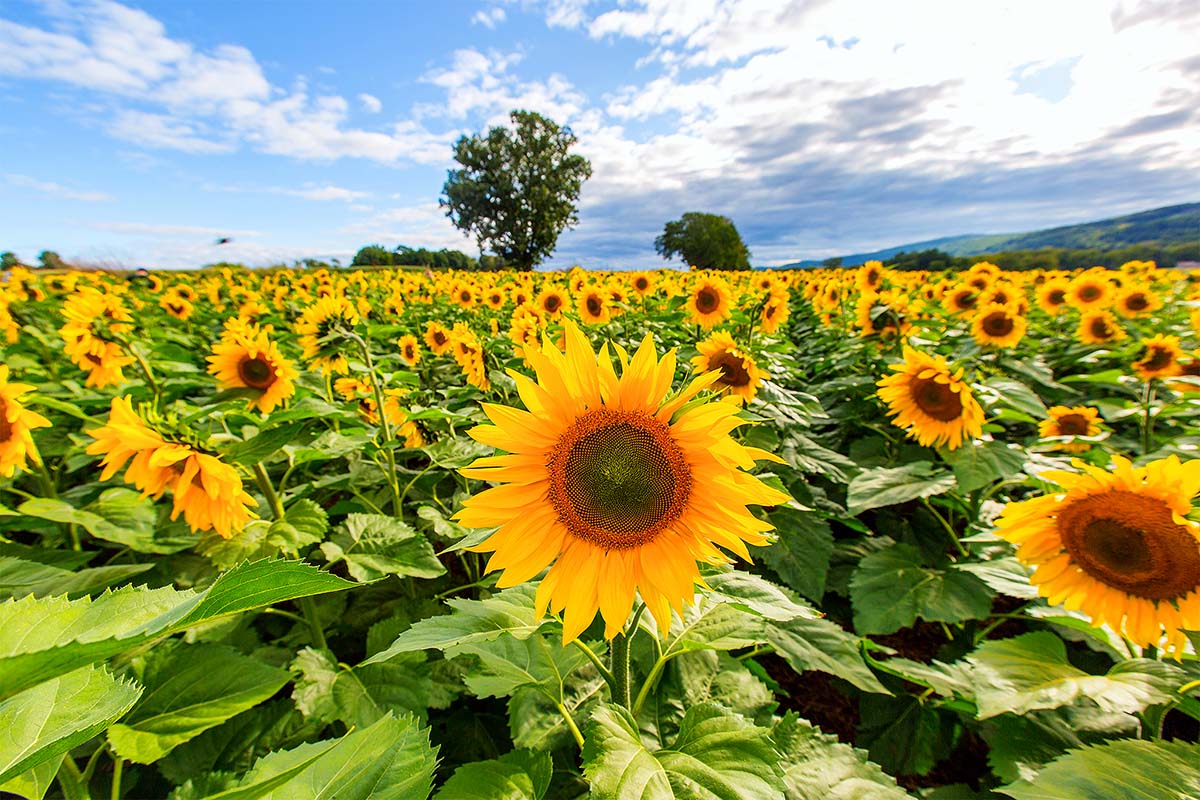
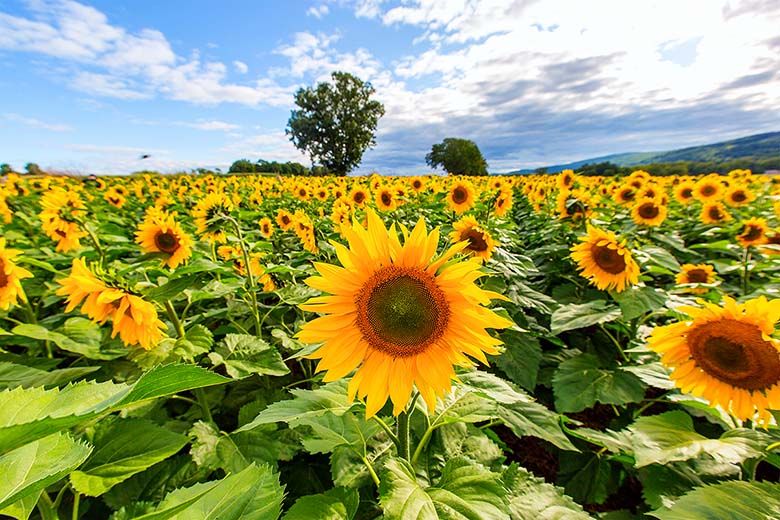
Canon 16-35mm f/2.8 (saebaryo)
Buying a Canon full-frame DSLR is a very exciting prospect, but deciding on the right EF-format lenses can be downright challenging. To help you wade through the masses of Canon EF (full frame) lens models, we’ve picked our ten favorites below along with seven that just missed the cut. You’ll find a wide range of options on this list including zooms and primes from wide angle and portrait to telephoto. Canon’s lens offerings are immense—not to mention the third-party models from brands like Sigma and Tokina—but there are plenty of excellent options across the price spectrum. For more information, see our Canon EF lens comparison table and lens buying advice below the picks.
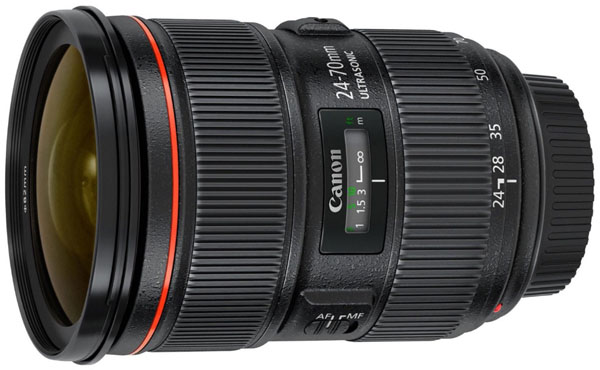
Category: Travel/portrait
Weight: 28.4 oz.
Image stabilization: No
What we like: Superb image quality and versatility.
What we don’t: A bit on the bulky side.
The 24-70mm f/2.8 is the quintessential all-purpose lens for professionals and enthusiasts who want premium image quality and versatility. This Canon EF lens pretty much does it all: it’s wide enough for landscape photography yet covers a healthy focal length range for portraits and travel. And with impressive sharpness and optical performance throughout, many people find that once they put the Canon 24-70mm f/2.8 on their camera, there aren’t a whole of lot situations where it needs to come off.
In terms of options at this popular focal length range, we heartily recommend the pricier f/2.8 over the f/4 version. We don’t always go this route—see the 16-35mm and 70-200mm below—but this is one of Canon’s premier lenses and the f/2.8 maximum aperture gives you the low light performance, bokeh, and depth of field that you just won’t get from the f/4. For indoor and nighttime photos, which are common with this type of lens, the upgrade in image quality is well worth the price.
See the Canon 24-70mm f/2.8L II
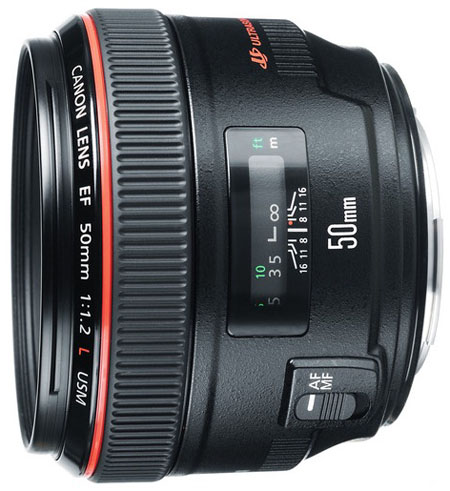
Category: Travel/portrait
Weight: 20.8 oz.
Image stabilization: No
What we like: Incredible depth of field and sharpness.
What we don’t: Very pricey for a prime lens.
Sometimes the world is a far better place through an f/1.2 lens. Expensive, yes, but the Canon 50mm f/1.2 is the premier portrait option for high-end DSLRs including the 5D Mark IV and 5DS R. With this lens you get superb low light performance, bokeh, depth of field, and sharpness. If you specialize in people photos and want the best in terms of image quality, this 50mm f/1.2 should not disappoint.
The downsides of the Canon 50mm f/1.2 are clear: a very high price tag for a prime lens along with a relatively high weight. You can save with various f/1.4 versions and the Canon 50mm f/1.8 below is only $125, but the step down in image and build quality is pretty substantial across the board. If you frequently shoot portraits and plan on having a 50mm on your camera a good chunk of the time, the cost of this lens is worth it. If not, the Sigma 50mm f/1.4 Art and Canon 50mm f/1.4 are viable alternatives for less.
See the Canon 50mm f/1.2L
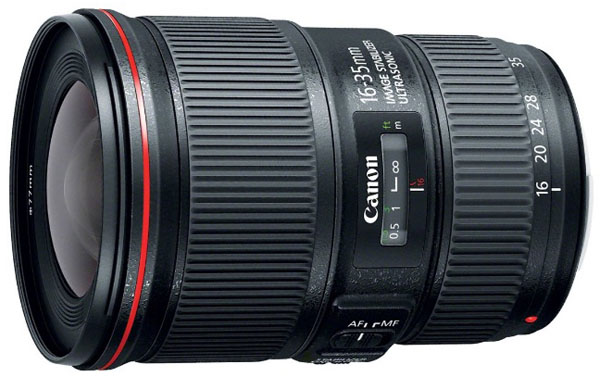
Category: Wide angle
Weight: 21.7 oz.
Image stabilization: Yes
What we like: Lighter and considerably less expensive than the 16-35mm f/2.8 below.
What we don’t: Not as good in low light.
For those who spend a lot of time outdoors, a quality wide-angle zoom can open up a world of possibilities. In this category we like the 16-35mm f/4 best, which isn’t as strong in low light as the uber-expensive f/2.8 III below but comparable on most other fronts. With this lens you get great sharpness, reasonable levels of distortion, and a high quality “L” series build that Canon is known for. And at around $725, it’s a great value for a pro-level wide-angle zoom.
At the 16-35mm focal length range, the f/4 vs. f/2.8 debate is an interesting one. A healthy percentage of people shoot wide-angle photos in daylight, not to mention bokeh is less relevant than with a portrait lens like a 24-70mm. Given the Canon 16-35mm f/4 is less than half of the price of the 16-35mm f/2.8, considerably smaller and lighter, and comes with image stabilization, we give the nod to the f/4 version. If you specialize in things like sunsets or event photography at night, the f/2.8 may be worth the extra cost and weight. For most other people, we prefer to save with the 16-35mm f/4.
See the Canon 16-35mm f/4L IS
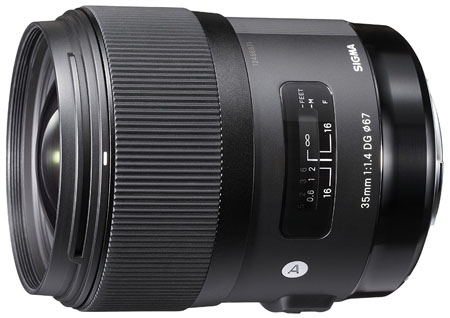
Category: Travel/portrait
Weight: 23.5 oz.
Image stabilization: No
What we like: $800 less than the Canon 35mm f/1.4.
What we don’t: Autofocus can be slow.
Sigma is one of our favorite manufacturers of third-party lenses, offering up unique options that generally are faster and cheaper than Canon’s native offerings. And the company has been hitting it out of the park of late with its Art series, which features fast f/1.4 lenses at focal lengths like 35mm, 50mm, and 85mm, among others. For those who shoot street photography, the Sigma 35mm f/1.4 Art is our top EF lens choice at this focal length and considerably cheaper than the Canon 35mm f/1.4 ($1,649).
What do you sacrifice by going with Sigma? Autofocus can be slightly slower than with a native Canon lens (you may want to calibrate the lens upon receiving it, which isn’t optimal for some people). And you don’t get quite the same build quality as Canon either, although this Sigma lens is pretty well made. We still like the Canon 35mm f/1.4, but at nearly double the price, we recommend the Sigma instead.
See the Sigma 35mm f/1.4 Art
Category: Telephoto
Weight: 27.5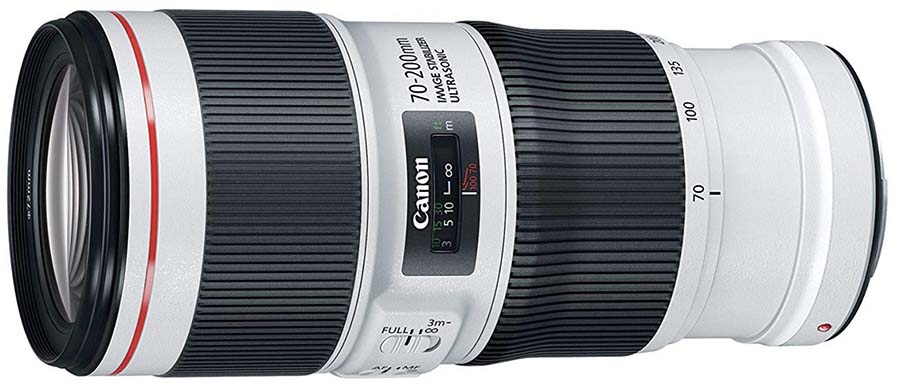 oz.
oz.
Image stabilization: Yes
What we like: Useful focal length range at a reasonable price and weight.
What we don’t: Photos in dim light can be challenging.
To complete your camera bag, a 70-200mm is the most popular telephoto option and compliments a lens like a 24-70mm above nicely. Canon has two main 70-200mm versions to choose from: an f/4 and an f/2.8. Both are “L” series lenses with excellent optics and both have image stabilization, but the f/2.8 is nearly twice the price and weight. If you absolutely need the extra low-light capability—think serious wildlife photographers who shoot at dawn and dusk—go with the f/2.8 (although we’ve used the f/4 on a number of trips and it works surprisingly well when shooting handheld in low light). Otherwise, the Canon 70-200mm f/4 is a better value and easier to carry.
Canon released its second iteration of this lens last year, which offers major improvements in image stabilization. Namely, Canon retooled the previously noisy motor and added a third image stabilizing mode meant for capturing fast-moving objects. The updated 70-200mm f/4 also includes a better, more protective lens coating as well as a shorter minimum focusing distance of around one meter (the previous version was 1.2). All in all, so long as you don’t need the faster f/2.8 maximum aperture, this lens has a useful place in just about everyone’s kit.
See the Canon 70-200mm f/4L IS II
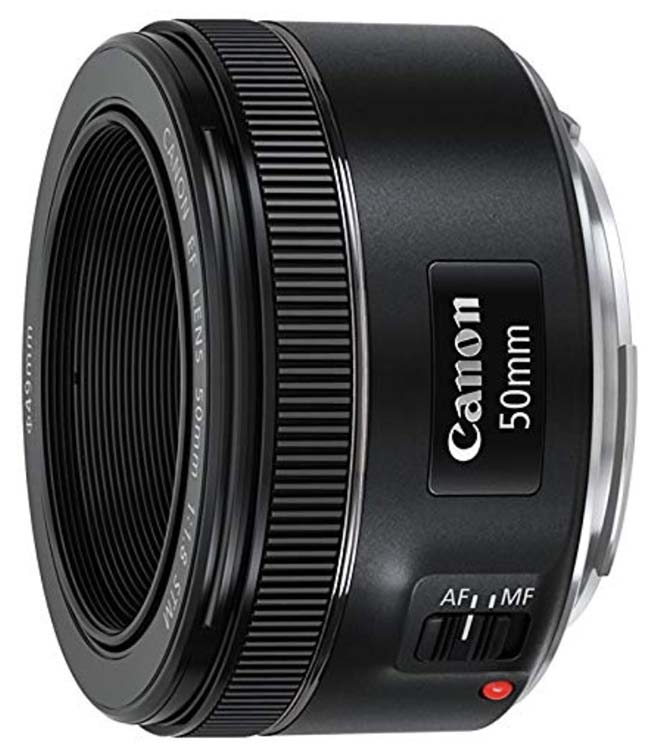 Category: Travel/portrait
Category: Travel/portrait
Weight: 5.6 oz.
Image stabilization: No
What we like: Good optics and super cheap.
What we don’t: Questionable build quality.
Canon’s lineup of nifty fifties is interesting to say the least, and even a bit polarizing in terms of the choices. We’ll start by saying that for professionals, we love the 50mm f/1.2 above. There is just no replacement for the depth of field and low light performance that an f/1.2 can produce. Having said that, the 50mm f/1.8 literally is one-tenth the price yet considerably better than that from an image quality perspective. Compromises include a mostly-plastic build and autofocus that won’t blow you away with its speed, but this a terrific full-frame lens for those on a budget.
Why isn’t the Canon 50mm f/1.4 listed here instead? It’s a really close call at the end of the day: the f/1.4 is a reasonable $329, has more metal and a higher quality build overall than the f/1.8, and of course, you get a faster maximum aperture by two-thirds of a stop. However, the f/1.4 can be a bit softer than we like for a prime and the autofocus can be slow and inaccurate. The truth is that you really can’t go wrong with any of Canon’s three 50mm offerings at their respective price points, but based of the factors mentioned above, we give the slight nod to the f/1.8 here.
See the Canon 50mm f/1.8 STM
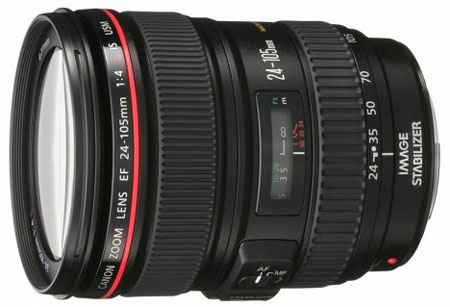
Category: Travel/portrait
Weight: 23.6 oz.
Image stabilization: Yes
What we like: A quality walk-around travel lens at a reasonable price.
What we don’t: Suffers from from center softness.
Travel zooms have become increasingly popular in recent years, offering maximum versatility for less money than a bag full of primes. If you don't want to spend up for our top choice, the Canon 24-70mm f/2.8 above, but want even more reach than the 24-70mm f/4 below, the 24-105mm is a very solid option. This lens is decently sharp throughout its zoom range, focuses well, and has image stabilization. But perhaps its biggest selling point is the focal length range, which covers everything from landscape shots to close-up portraits (it has an additional 35mm over the popular 24-70mm).
Where does the Canon 24-105mm f/4 fall short? First, for generation two, it seems like Canon sacrificed center sharpness at certain focal lengths to improve the edge sharpness. In addition, you'll notice some distortion, and particularly toward the ends, but this is to be expected from a lens of the type. Third, the maximum aperture of f/4 isn’t ideal for low light and won’t give you that creamy bokeh of an f/2.8 lens. But we love the relatively low price point for an “L” series lens: at just over $1,000, the 24-105mm f/4 is one of the better values on this list.
See the Canon 24-105mm f/4L

Category: Portrait
Weight: 36.2 oz.
Image stabilization: No
What we like: Super fast and sharp.
What we don’t: Heavy and expensive.
For those who specialize in portrait photography, the Canon 85mm f/1.2 is the finest EF lens on the market. Similar to the 50mm above, f/1.2 is a special place to be and offers bokeh that just isn’t possible from f/1.4 and f/1.8 lenses, which are considered fast by normal standards. In addition, the 85mm f/1.2 is tack sharp even when wide open and has a no-nonsense “L” build that should last as long as you take care of it.
Interestingly, the Canon 85mm f/1.2 is not known for focusing quickly. This usually isn’t a requirement for this type of lens, however, as portrait shooters prioritize bokeh and maximum light entering the lens over speed. Another downside is that it’s extremely heavy for a prime lens at well over 2 pounds. These issues aside, the image quality produced by this Canon 85mm f/1.2 is superb and should not disappoint even the most discerning of photographers. For another quality option at this focal length, try the Sigma 85mm f/1.4.
See the Canon 85mm f/1.2L
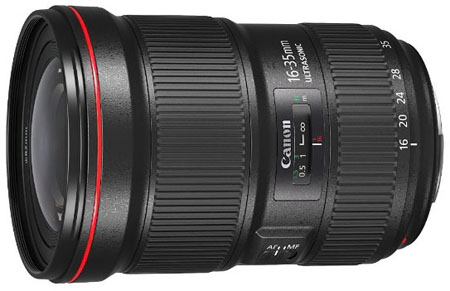
Category: Wide angle
Weight: 27.9 oz.
Image stabilization: No
What we like: Excellent sharpness all the way to the corners.
What we don’t: More than double the price of the f/4 version.
If serious wide-angle photography is the name of your game, it’s worth investing in the Canon 16-35mm f/2.8 III over the 16-35mm f/4 above (or previous versions of the 16-35mm f/2.8, for that matter). This lens pretty much does it all: it’s extremely sharp all the way to the corners (corner sharpness was an issue with the Mark II), has minimal distortion, and offers superior depth of field and bokeh compared to the 16-35mm f/4. All things considered, you won’t find a better wide-angle zoom for Canon EF from any brand.
The biggest hurdles in choosing the Canon 16-35mm f/2.8 III are its cost and size. Nearly $2,000 is a hefty price to pay—this is one of the most expensive wide-angle zooms that we know of—and the lens weighs a whopping 27.9 ounces. Neither of these should matter much to wide-angle professionals who demand the absolute best, but for those who only plan on dabbling in this area of photography, the 16-35mm f/4 above is a fine option.
See the Canon 16-35mm f/2.8L III
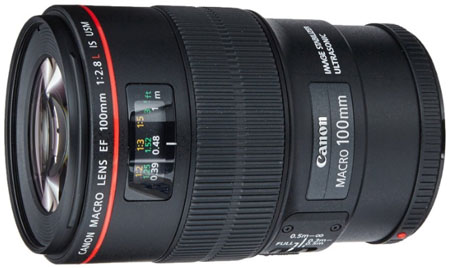
Category: Macro/portrait
Weight: 22 oz.
Image stabilization: Yes
What we like: Tack sharp.
What we don’t: One of the least versatile lenses on this list.
For macro photography and close-up portraits, the 100mm f/2.8 from Canon is a no-brainer. This lens is extremely sharp, focuses quickly and accurately, and has a premium “L” series build. More, it’s a good value at around $800—you’ll pay $1,900 for the 85mm f/1.2 that is one-half-stop faster but fairly comparable in terms of overall image quality. Both can be used for portraits, but the 100mm f/2.8 has a 12-inch minimum focusing distance for the Macro side of things.
Keep in mind that unlike a quality 50mm prime, this isn’t your everyday walk-around lens. 100mm is great for close-up portraits and capturing the details, but it’s not an ideal focal length for most travel or street photography. Even for people, it’s pretty darn close. But for serious macro and portrait photographers, the Canon 100mm f/2.8 is a must-have lens.
See the Canon 100mm f/2.8L Macro
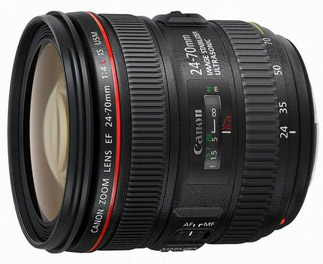
Category: Travel/portrait
Weight: 21.2 oz.
Image stabilization: Yes
What we like: Better optical performance than the 24-105mm f/4.
What we don’t: Lacking the bokeh of the 24-70mm f/2.8.
If you want the coveted 24-70mm focal length range without breaking the $1,000 barrier, the Canon 24-70mm f/4 is the way to go. Yes, this lens is not as good as the f/2.8 above for portraits or indoor photography in low light, but it’s a good option for travel and event photography in normal light. Simply put, if you don’t need a ton of bokeh but still want Canon “L” series build and image quality, the 24-70mm f/4 is a nice value.
Perhaps the biggest competition to the 24-70mm f/4 is the 24-105mm f/4 above. We like both lenses, and the 24-105mm does offer an extra 35mm of coverage at the telephoto end of the spectrum, but the 24-70mm is sharper, focuses better, and lighter. If people photos are a central part of your photography and you can afford the 24-70mm f/2.8, go for it. Otherwise, the 24-70mm f/4 is a fine choice.
See the Canon 24-70mm f/4L
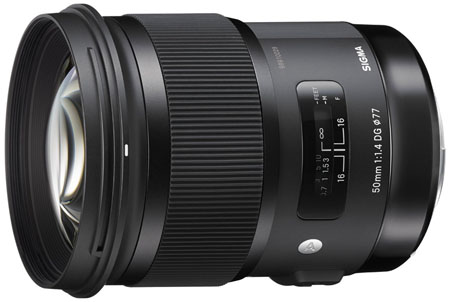
Category: Travel/portrait
Weight: 28.7 oz.
Image stabilization: No
What we like: Premium image quality.
What we don’t: It can’t beat the Canon 50mm f/1.2.
Without repeating ourselves too much, we really like Sigma’s Art series. The lenses are fast, well built, and less expensive than Canon’s comparable native offerings. At the popular 50mm focal length, the image quality of the Canon 50mm f/1.2 above is the cream of the crop, but over $1,300 is a lot to spend on one prime lens. The Sigma 50mm f/1.4 isn’t cheap by any means, but it is a more economical alternative that doesn’t sacrifice a ton in terms of image quality.
Of the pro-level options, the third and least desirable option at this focal length is the Canon 50mm f/1.4, which is considerably cheaper than either the Canon f/1.2 or Sigma f/1.4. That lens, however, isn’t nearly as sharp as the Sigma (sharpness is key with a 50mm prime on a full-frame camera), and many people use it instead on Canon crop-frame cameras with an 80mm equivalent. But given that most amateur photographers cover 50mm with a zoom like the 24-70mm or 24-105mm, a 50mm prime must be serious to be considered. The Sigma 50mm f/1.4 Art certainly is.
See the Sigma 50mm f/1.4 Art
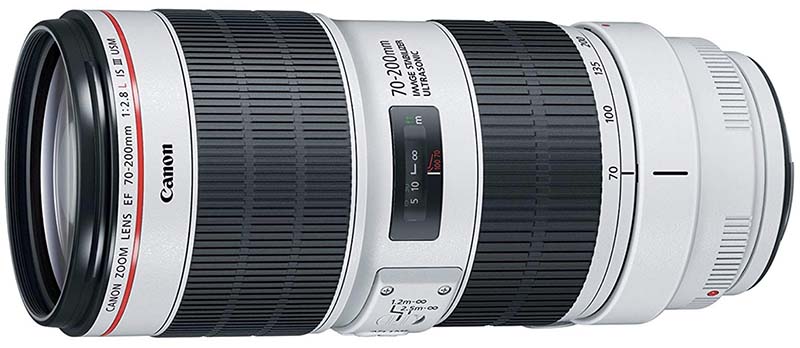 Category: Telephoto
Category: Telephoto
Weight: 52.2 oz.
Image stabilization: Yes
What we like: Impressively crisp images.
What we don’t: By far the heaviest lens on this list.
We stated our preference for the Canon 70-200mm f/4 above, which is cheaper, lighter, and comes with image stabilization. However, there is no doubt that the f/2.8 is superior from an optical perspective and the right choice for serious telephoto photographers. The images produced by this lens are surprisingly sharp across virtually the entire zoom range, and the image stabilization—improved for this second iteration—helps offset camera shake, which can be a serious issue with a heavy and long lens like this one.
What are the shortcomings of this Canon 70-200mm f/2.8? Most notable is the 52.2-ounce weight (that is not a misprint—this lens comes in at well over 3 pounds). This means that you’ll most likely want to use a tripod, which for those shooting outdoors far from the car, adds even more complexity and weight to the equation. However, we can’t help but love the incredibly crisp images and creamy bokeh. For those who prioritize image quality over all else, it’s a must-have telephoto lens for Canon full-frame cameras.
See the Canon 70-200mm f/2.8L IS III
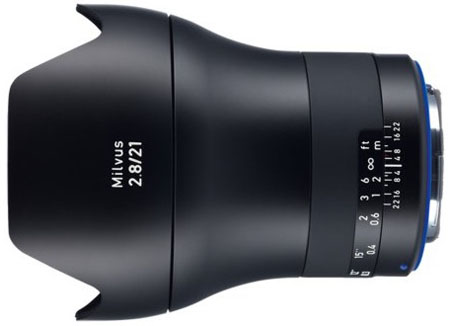
Category: Wide angle
Weight: 30 oz.
Image stabilization: No
What we like: Incredibly sharp and almost no distortion.
What we don’t: Pricey and manual focus isn’t for everyone.
This wouldn’t be a proper list without including a quality wide-angle prime. Photography nuts love Zeiss lenses, many of which are made for Sony’s mirrorless camera lineup. But the manual focus Milvus 21mm is one of the world’s finest wide-angle primes, replacing the old Distagon series and made in mounts for both Canon EF and Nikon F.
Why is the Zeiss Milvus 21mm so exceptional? It’s extraordinarily sharp all the way to the corners, has almost no distortion, and offers great contrast thanks to Zeiss’ anti-reflection coating on the glass. We also love the sturdy build, which adds some weight but means that the lens should far outlast your camera. If you haven’t tried manual focus, this is an expensive way to learn. Most of those who do, however, discover it’s easy, more accurate, and fun. And for a native wide-angle prime from Canon with autofocus, try the 24mm f/1.4.
See the Zeiss Milvus 21mm f/2.8
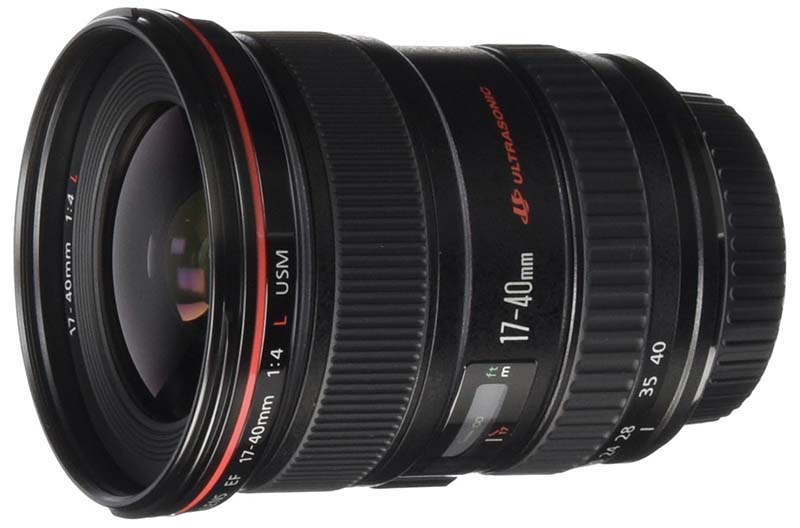 Category: Wide angle
Category: Wide angle
Weight: 17.6 oz.
Image stabilization: No
What we like: A screaming deal for an “L” series lens.
What we don’t: Tends to be soft at the corners.
If you’re in the market for a Canon full-frame lens and don’t mind an oldie but goodie, check out the 17-40mm f/4L. We’ll start with the bad: this lens was released all the way back in 2003, but there’s an argument that doesn’t matter a whole lot in the lens world. From an image quality perspective, you’ll definitely notice some softness toward the edges of the frame, and particularly at the wide end and when wide open. And not surprisingly, the lens has a healthy amount of distortion, but that can be corrected in-camera or in post processing.
On to the good news: currently offered for less than $500, the Canon 17-40mm f/4 is a whopper of a deal for an L series lens. You get almost all of the wide-angle capability of the 16-35mm f/4 above, even more reach at 40mm, and the same maximum aperture, all for half the price. For those who want to experiment with wide-angle photography without committing the big bucks, the Canon 17-40mm is a great value. It’s worth noting that this lens has been significantly discounted of late (the MSRP is $799), so it’s possible that a replacement is in the works.
See the Canon 17-40mm f/4L
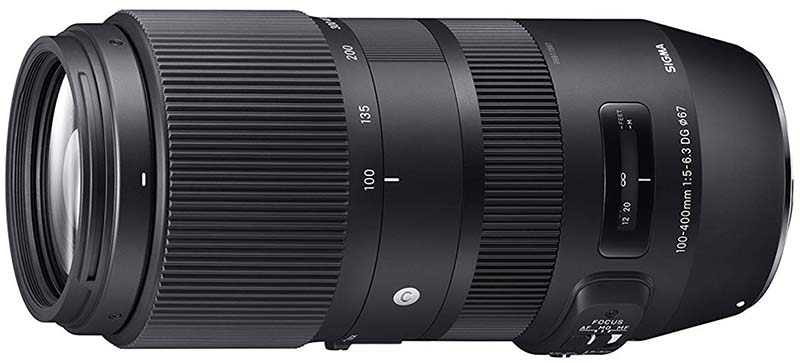 Category: Telephoto
Category: Telephoto
Weight: 40.9 oz.
Image stabilization: Yes
What we like: Huge zoom range.
What we don’t: Poor low light performance.
In terms of telephoto reach, 200mm of zoom is nice, but 400mm is a whole lot better. For serious wildlife and action photographers—or anyone else who finds the extended reach useful—the Sigma 100-400mm f/5-6.3 is a whopper of a lens. In normal lighting, it can produce sharp images in a variety of conditions. And for less than $700, you’d be hard-pressed to find another super tele of this caliber within the same price range.
The drawbacks of the Sigma are noticeable when compared to the Canon 100-400mm f/4.5-5.6, the most obvious of which are low-light capabilities. When hitting the longer focal lengths, the Sigma opens up to a mere f/6.3, which can make shooting in anything but bright light difficult. The Canon also boasts superior autofocus and is slightly sharper, but that’s to be expected with a much pricier pro-level lens that will run you $1,800. Professional wildlife photographers likely will want to spend up for the Canon, but if you want to experiment on the super telephoto end of the spectrum without breaking the bank, we like the Sigma.
See the Sigma 100-400mm f/5-6.3
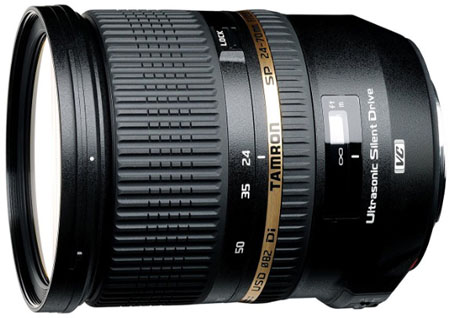
Category: Travel/portrait
Weight: 31.9 oz.
Image stabilization: Yes
What we like: Sharp and good in low light.
What we don’t: Autofocus isn’t up to par.
We'll start by saying that we want to like the Tamron 24-70mm f/2.8 as a cheaper alternative to Canon’s native f/2.8 offering. In the crop-sensor realm, for example, a number of Tamron and Sigma zooms are very competitive. Unfortunately, it’s hard for us to recommend Tamron’s 24-70mm f/2.8 for Canon EF. Yes, it has the same maximum aperture as our top pick, but the price difference is only $400 and the Canon is considerably better in both optical performance and build quality.
Where does the Tamron 24-70mm f/2.8 fall short? As with many third-party lenses, autofocus can be inaccurate and sometimes slow. And although this lens is weather sealed for protection from the elements, it’s not quite up to Canon’s L series build quality. On the upside, sharpness is impressive pretty much across its zoom range. With a further price drop or rebate we like the Tamron 24-70mm f/2.8 more, but at $1,200 we prefer to spend up for the Canon.
See the Tamron 24-70mm f/2.8
| Lens | Price | Category | Weight | Aperture | IS | Filter |
|---|---|---|---|---|---|---|
| Canon 24-70mm f/2.8L II USM | $1,599 | Travel/portrait | 28.4 oz. | f/2.8 | No | 82mm |
| Canon 50mm f/1.2L USM | $1,299 | Travel/portrait | 20.8 oz. | f/1.2 | No | 72mm |
| Canon 16-35mm f/4L IS USM | $999 | Wide angle | 21.7 oz. | f/4 | Yes | 77mm |
| Sigma 35mm f/1.4 Art | $725 | Street/travel | 23.5 oz. | f/1.4 | No | 67mm |
| Canon 70-200mm f/4L IS II USM | $1,299 | Telephoto | 27.5 oz. | f/4 | Yes | 72mm |
| Canon 50mm f/1.8 STM | $125 | Travel/portrait | 5.6 oz. | f/1.8 | No | 49mm |
| Canon 24-105mm f/L II IS USM | $898 | Travel/portrait | 50.4 oz. | f/2.8 | Yes | 77mm |
| Canon 85mm f/1.2L USM | $1,849 | Portrait | 36.2 oz. | f/1.2 | No | 72mm |
| Canon 16-35mm f/2.8L III USM | $1,899 | Wide angle | 27.9 oz. | f/2.8 | No | 82mm |
| Canon 100mm f/2.8L IS USM | $749 | Macro | 22 oz. | f/2.8 | Yes | 67mm |
| Canon 24-70mm f/4L IS USM | $849 | Travel/portrait | 21.2 oz. | f/4 | Yes | 77mm |
| Sigma 50mm f/1.4 Art | $707 | Travel/portrait | 28.7 oz. | f/1.4 | No | 77mm |
| Canon 70-200mm f/2.8L III IS USM | $1,899 | Telephoto | 52.2 oz. | f/2.8 | Yes | 62mm |
| Zeiss Milvus 21mm f/2.8 | $1,499 | Wide angle | 30 oz. | f/2.8 | No | 82mm |
| Canon 17-40mm f/4L USM | $499 | Wide angle | 17.6 oz. | f/4 | No | 77mm |
| Sigma 100-400mm f/5-6.3 OS | $646 | Super telephoto | 40.9 oz. | f/5-6.3 | Yes (OS) | 67mm |
| Tamron 24-70mm f/2.8 | $1,199 | Travel/portrait | 31.9 oz. | f/2.8 | No | 82mm |
One of the first decisions you’ll need to make when choosing a Canon EF lens is zoom vs. prime. Zoom lenses cover a range of focal lengths (24-70mm, for example), while primes have a fixed focal length (35mm and 50mm are common primes). Generally, zoom lenses are much more versatile and require you to change lenses less if at all, while primes win out in optical quality with faster maximum apertures and less distortion.
The short answer is that most people—and amateur photographers in particular—should start with a good zoom lens. All Canon full-frame digital SLRs are offered with a kit lens, either a 24-70mm f/4 or 24-105mm f/4. These lenses cover everything from wide-angle photos to portraits, and if you add a 70-200mm lens, you’ll have great coverage across the most commonly used focal lengths.
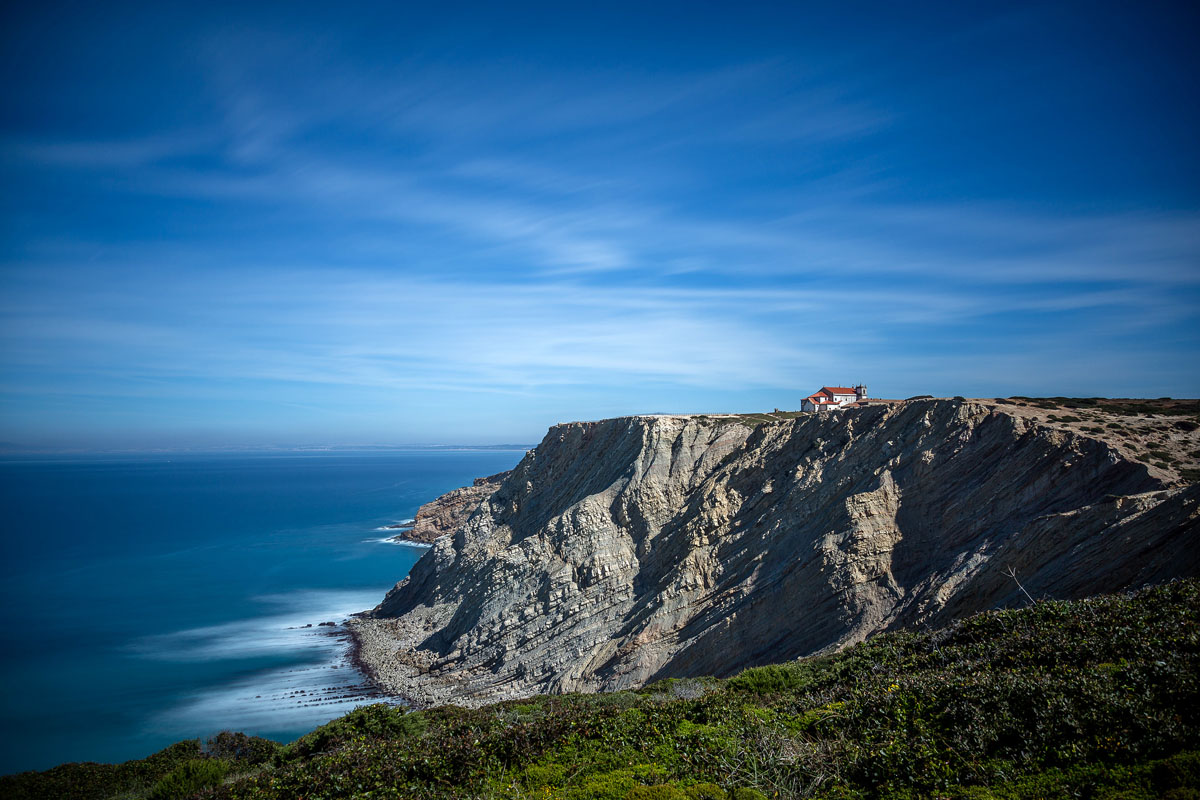
Professionals and enthusiasts who specialize in a certain type of photography often buy primes at their most used focal lengths. For example, many pro landscape photographers have an 18mm or 21mm prime that they use for their print-quality photos (Canon’s 16-35mm f/2.8L III is an excellent wide-angle lens as well but not quite on par with a premium prime). And most serious portrait photographers will have 50mm or 85mm primes that are faster and sharper than any zoom.
There are a couple notable exceptions to the prime vs. zoom distinctions covered above. Certain “pro” zooms do a pretty darn good job at mimicking the quality of prime lenses at their respective focal lengths. The Canon 24-70mm f/2.8L II (ranked #1 on this list) is a superb all-around lens often used by portrait and wedding photographers. The 16-35mm f/2.8 III is pretty darn impressive as well and commonly used by serious outdoor and adventure photographers. If you want the best in a zoom, we recommend going with an f/2.8 version or faster (more on maximum aperture below).
Aside from choosing a focal length(s) and the type of lens (zoom vs. prime), maximum aperture is the next big decision. In short, aperture is the size of the lens opening through which light passes, and it impacts just about everything related to image quality: bokeh, depth of field, and sharpness. Aperture is measured using the f-stop scale, and the lower the f-stop (f/2.8, f/1.8, f/1.4, etc.), the larger the opening and the more light can enter. You can see the full f-stop scale here, and lower numbers make for more desirable (and expensive) lenses.

In terms of numbers, we generally make the professional cutoff at f/2.8. Lenses with this maximum aperture or faster are solid low light performers and can help you achieve the creamy bokeh that professionals love. Many cheaper zoom lenses have a maximum aperture of f/4 or slower, which is respectable but can cause some challenges when natural light is low. Canon’s image stabilization (IS) technology helps, as does the use of a tripod, but there’s no replacement for a fast lens. An f/1.4 or f/1.2 lens can create image quality and bokeh that no f/4 lens can match.
Canon’s leading EF (full-frame) lenses receive the “L” designation, which includes a lot of cachet along with a thin red band around the barrel. Canon isn’t super clear about what exactly “L” means, but the prevailing theory is that it stands for “Luxury.” Many (but not all) of these lenses are weather resistant and have high quality elements including ultra-low dispersion glass. The “L” series is dominated by lenses that are f/2.8 and faster, but the company has stretched it to include models like the 24-105mm f/4L and 24-70mm f/4L.
We take the “L” distinction with a grain of salt. It certainly means something—you’re choosing a serious lens at or near the top of the Canon heap—but there sure are quite a few “L” lenses. We think that some universal standard would be helpful: perhaps all “L” lenses should be weather sealed or have a maximum aperture of f/2.8 or faster. That’s up to Canon, but there’s no argument that you’re getting a serious piece of glass with an “L” lens.
When shopping for EF lenses for your full-frame system, a number of third-party manufactures (Sigma, Tamron, and Tokina) make lenses that are compatible with Canon cameras. These lenses often are cheaper than their Canon counterparts, which is one of their big selling points. On this list, 12 are Canon native lenses with 3 made by third-party manufacturer Sigma. We also included the Zeiss Milvus 21mm f/2.8 and Tamron 24-70mm f/2.8.
The most common complaint with third-party lenses is autofocus. Because Sigma or Tamron makes the same lens with multiple mounts (Nikon or Sony too, for example), and given that they don’t make the actual camera, autofocus tends to be a little slower and less accurate than a native Canon lenses. It’s also common to find a little more plastic in the build. However, third-party lenses often are considerably cheaper at the same focal lengths and apertures. Sigma in particular has been very impressive with their “Art” series of f/1.4 lenses, which are well built and often cheaper than Canon’s prime lineup.
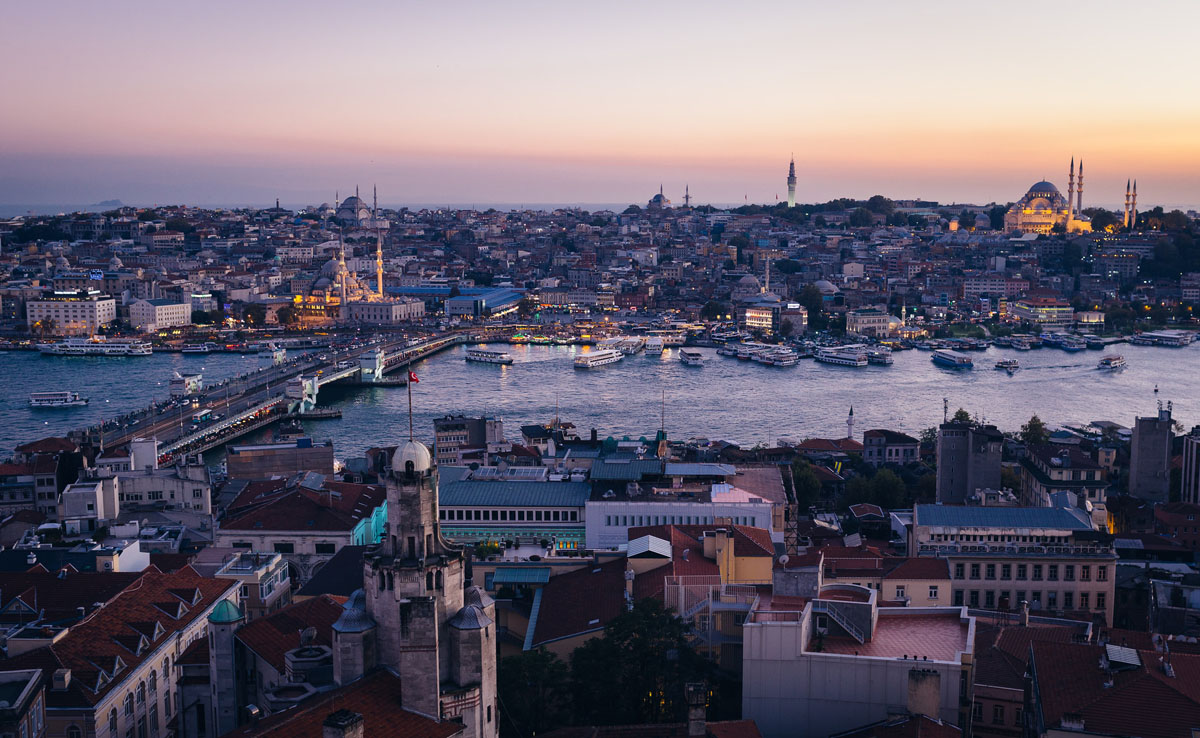
We recommend making each lens choice independently and considering good third-party opportunities when available. They’re great for those on a budget or who want to experiment at a particular focal length without committing as many resources. Just make sure to have reasonable expectations with third-party lenses. Like many things, you often get what you pay for when buying lenses. The best models are expensive and cheaper ones usually come with some sacrifices.
Given that we shoot a lot of outdoor and travel photography and therefore carry lenses on our back over long distances, we can tell you that weight matters. The bottom line is that most people reading this article have decided that image quality is paramount—that’s why you choose a full-frame camera—and carrying 5 or so extra pounds on your adventures is worth it. But we’ve included weight in both our product specs and in our comparison table for reference.
Some good news for Canon DSLR owners who may be considering a mirrorless interchangeable-lens camera: you won’t save as much weight going mirrorless as you might think. Full-frame mirrorless cameras like the Sony Alpha A7R II (22.1 ounces) certainly weigh less than Canon full-frame DSLRs like the Canon EOS 5D Mark IV (31.4 ounces). But many mirrorless lenses are roughly the same weight as their DSLR counterparts, so the total weight savings is minimal. For example, we recently purchased the Sony 24-70mm f/2.8G (31.3 ounces), and it’s actually heavier than the Canon 24-70mm f/2.8 (28.4 ounces). Mirrorless cameras do have smaller form factors and are somewhat lighter, but it’s not as big of a gap as many people think.
Lenses are less at risk from the elements than camera bodies, but still can be impacted by dust, moisture, and anything else that can seep into your equipment. This is where price often comes into play. Typically, the more expensive the lens is, the higher quality the build will be, which often translates to more weather resistance. Canon has a reputation for creating durable, long-lasting lenses that can withstand the elements, and if you’re looking for the best weather protection, you’ll want shop for their glass marked with the “L” designation.
Even with a weather-sealed camera, we definitely don’t recommend shooting in a sustained downpour as water eventually can get through, but weather sealing can be very helpful in light to moderate precipitation. If you’re a professional who shoots outdoors, it’s a must. And for those hoping to get the most life out of their lens, a rain cover is a great investment. We’ve gotten our lenses fairly soaked without any negative effects, but we understand that might not seem like a great idea to some. If your lens does happen to take on some water, we recommend sticking it in a plastic bag with silica gel packets or covering it with a dry towel to absorb the moisture.
This article covers Canon EF (full frame) lenses, but there is another world of EF-S (or APS-C) lenses for the company’s entry-level and mid-range DSLRs. In short, EF-S lenses are not compatible on full-frame cameras. To start, most native Canon EF-S lenses will not physically mount on Canon full-frame cameras. And while some third-party lenses designed for crop-sensor cameras technically have an EF mount, we strongly recommend against using them on full-frame camera bodies. Image quality will be compromised and you can actually cause damage to the camera’s mirror.
On the other hand, EF-mount lenses are compatible on crop sensor (APS-C) cameras. EF lenses are much more expensive and larger than EF-S lenses, and it’s questionable economically and practically to purchase a full-frame lens specifically for a crop-sensor body. But if you already own EF lenses and want to try them on an entry-level camera, this should not cause technical difficulties.
Back to Our Top Canon EF Lens Picks Back to Canon EF Lens Comparison Table